David Noel
<davidn@aoi.com.au>
Ben Franklin Centre for Theoretical Research
PO Box 27, Subiaco, WA 6008, Australia.
DS910: Arkiduct Propulsion in Large Marine Vessels
Abstract
Arkiduct devices are based on electrically-driven Archimedes screws, and can be axle-less because they can function like the rotor and stator of an electric motor or generator. They can be used for propulsion and liquid delivery, as well as motors and generators. They are described in [1].
This article discusses use of Arkiducts in the propulsion of large marine vessels such as container ships, cruise liners, and tankers, many of which have displacements of over a hundred thousand tons, and can be as much as half a million tons [2].
History of the Archimedes Screw
The invention of the water-raising device known as the Archimedes Screw, and in use for more than 2000 years, is traditionally attributed to the Greek engineer and mathematician Archimedes (ca 287-211 BC).
However, recent evidence [3] shows that the screw was in use several hundred years before Archimedes was born, in the "Hanging Gardens of Babylon", one of the traditional Seven Wonders of the ancient world.
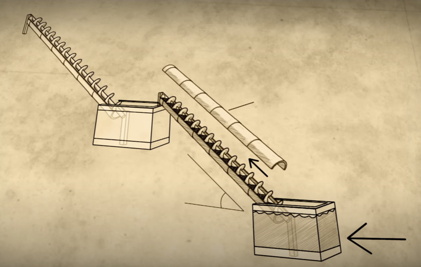
DS910-F1. Archimedes screw used for raising water. From [3].
The Hanging Gardens are now believed to have been built in the Babylonian capital of Ninevah, close to the modern city of Mosul in Iraq, by the Assyrian king Sennacherib in around 600 BC.
According to [4], Sennacherib’s construction of a new capital at Nineveh was a massive endeavour, and the city and its garden were supplied with a water management project unparalleled at the time. Sennacherib’s canal system, which was some 50 miles long and as wide as the Panama Canal in some sections, featured advanced sluice gates, aqueducts, millions of dressed stones, and waterproof cement.
Clay tablets from Nineveh show how the Hanging Gardens were irrigated by archimedes screws pumping water up into the gardens from these aqueducts.
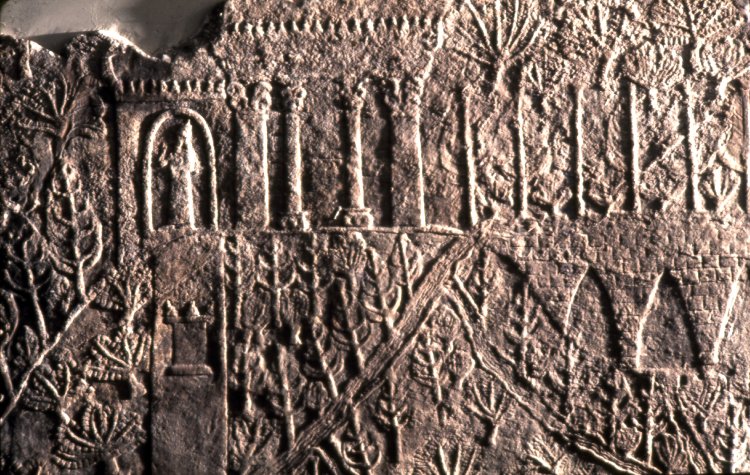
DS902-F2. Clay tablet from Ninevah showing Archimedes Screws raising water from aqueducts. From [4].
The working part of an Archimedes Screw consists of a helical blade, typically with a central axle, and often enclosed in a tube or trough. When the helical blade is rotated, it pulls in water at one end and expels it in the other.
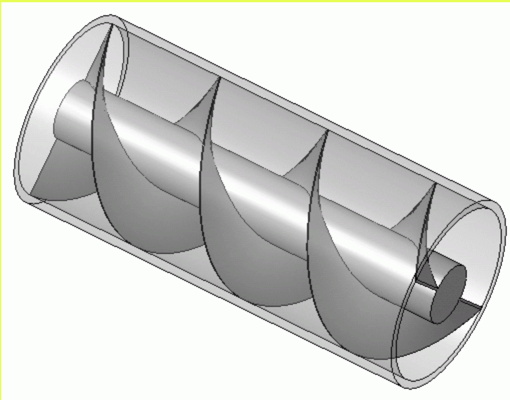
DS910-F3. Construction of an Archimedes Screw. From [1].
Ship Propellers and Screws
Most modern mechanically-driven ships are driven by propellers or screws which rotate in the water, the screw mechanism pulling in water from the direction in which the ship is travelling and ejecting it to the rear.
Modern propellers have evolved from earlier screw types with multiple threads. In 1794 a triple-threaded screw was patented by William Lyttleton [6]. This propeller was designed for mounting in a frame attached to the ship’s hull. It was to have been driven by manually-operated winches through a system of ropes and pulleys. A boat fitted with this device was tried in Greenland Dock, London, but a speed of only two miles an hour was attained.
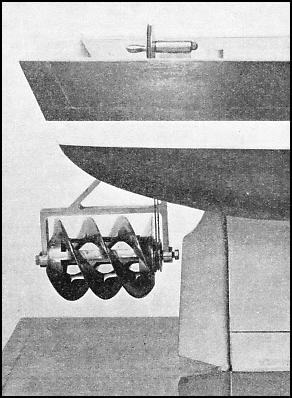
DS910-F4. Triple-threaded ship screw patented in 1794. From [6].
Later trials showed better results by reducing the number of threads, and eventually the modern design, essentially a set of 3 or more parts of threads, called blades, was arrived at. Such propellers are used in a big range of sizes, from small ones on outboard motors clamped onto dinghies or inflatables, up to giant ones for driving huge marine vessels.
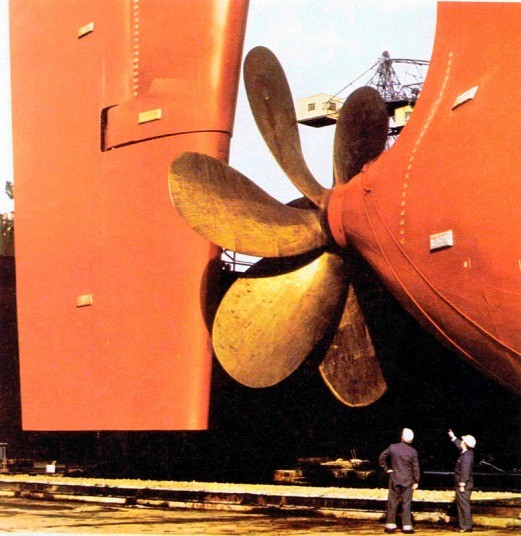
DS910-F5. Nine-metre diameter ship propeller from Hapag-Lloyd container ship. From [5].
Figure F5 shows one such propeller, fitted to a Hapag-Lloyd owned container vessel. This vessel contains probably one of the largest ship propellers ever built. The six-bladed propeller is about 9.1 meter in diameter and weighs 101.5 tonmes. Its height can be compared to the height of a three storey building.
Limitations and Problems of Ship Propellers
Conventional propellers have a number of limitations to their efficiency and safety. One of the most important of these is a phenomenon known as Cavitation.
Cavitation. There is a good explanation of cavitation in Wikipedia [8], from which the following extracts are drawn.
"Cavitation is a phenomenon in which rapid changes of pressure in a liquid lead to the formation of small vapour-filled cavities in places where the pressure is relatively low.
When subjected to higher pressure, these cavities, called "bubbles" or "voids", collapse and can generate a shock wave that is strong very close to the bubble, but rapidly weakens as it propagates away from the bubble.
Cavitation is a significant cause of wear in some engineering contexts. Collapsing voids that implode near to a metal surface cause cyclic stress through repeated implosion. This results in surface fatigue of the metal causing a type of wear also called "cavitation". The most common examples of this kind of wear are to pump impellers.
Since the shock waves formed by collapse of the voids are strong enough to cause significant damage to parts, cavitation is typically an undesirable phenomenon in machinery. It is very often specifically avoided in the design of machines such as turbines or propellers, and eliminating cavitation is a major field in the study of fluid dynamics."
A practical examination of cavitation problems in ship propellers is available at [7], from which the following summary is extracted.
"There are four effects of cavitation, all of which are detrimental.
Performance suffers because the water can only support a limited suction, dependent upon the conditions. If the blade suction has a potential magnitude in excess of this limit, then the thrust is thus decreased and the efficiency falls.
Erosion of the propeller material will occur if the cavities collapse in the proximity of the blade surface. During collapse considerable pressures can be generated, capable of such intensities that no material can withstand the attack. Other forms of attack, such as corrosion and electrochemical action, are closely related to erosion.
Noise is produced during cavity collapse which can have considerable nuisance value, particularly in vessels with accommodation aft.
Vibration can be induced by cavitation due to the unsteady nature of the phenomenon involving large fluctuating forces. Recent research has indicated that cavitation has considerable influence on propeller induced pressure fluctuations".
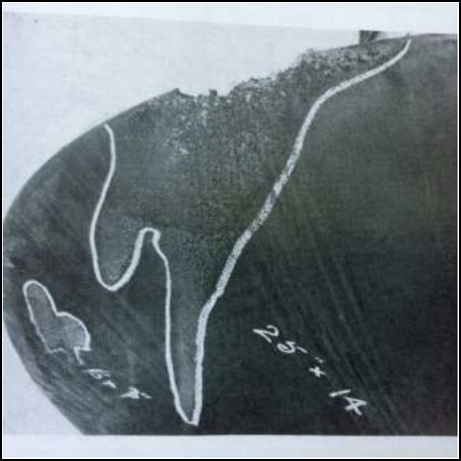
DS910-F6. Cavitation erosion of a ship propeller. From [7].
Naturally enough, all types of noise and vibration involve loss of energy, making the ship propulsion process less efficient.
Safety. There are, unfortunately, many cases of damage or loss of life, affecting both humans and marine animals, due to impact with ship propeller screws. In addition, exposed screws in open water can be easily fouled by floating debris or underwater structures or materials.
Wake damage.
The wakes caused by ship propellers transfer a lot of energy to the environment and can cause upset to boats floating in the vicinity. In river or canal surroundings, ship wakes can lead to serious erosion of banks or damage to pier structures.
Arkiduct Construction
The general form of construction of an Arkiduct is as shown in Figure F7. It consists of two parts.
.jpg)
DS910-F7. Construction of Arkiduct.
The inner part of the Arkiduct, the Rotor, will normally be a cylinder containing a fixed Archimedes Screw, so that it rotates as part of the Rotor. The central axle of the screw can be shrunk down to nothing, so that the screw is a pure helix, attached to the inner surface of the Rotor.
The outer part of the Arkiduct will normally be another cylinder, fixed in the containing piece of equipment. This equipment might be a pump, a propeller, a motor, or a generator. The Arkiduct is equipped with electrical wiring and magnets, as in a conventional motor or generator -- application of electrical power will cause the Rotor to rotate within the Stator.
This general picture may be modified in particular circumstances, for example, the cylinders involved might be bulged out in their central portions, with the inner screw or helix varying in width or pitch -- liquid travelling within an Arkiduct would then travel more slowly within the central section, as when a river comes to a wider separation of its banks.
The Marine Arkiduct -- Arkiducts used in Ship Propulsion
Archimedes Screws have been used in ship propulsion, as in Figure F4. Marine Arkiducts as described here would be specially suited to propulsion of large marine vessels.
Although a single Marine Arkiduct could be used to propel a vessel, the obvious choice would be to have two Arkiducts, one on each side of the vessel. The ship could then be steered by increasing or decreasing the relative rotation rates of the port and starboard Ducts -- there would be no need for a rudder. With both Ducts reversed in direction of rotation, the ship would go backwards, and with only one reversed, the ship would tend to rotate in a circle.
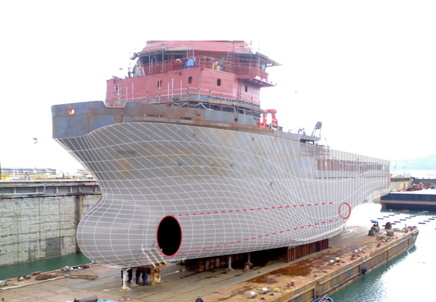
DS910-F8. Notional placing of Marine Arkiduct in conventional vessel. Base image from [9].
In an existing arrangement, large modern cruise ships, such as the Cunard Line's Queen Mary, can get excellent manoeuvrability by having auxiliary thruster pods (electrically-driven screws), which can be turned in any direction to modify the main propeller action.
Advantages of Marine Arkiducts over conventional Ship Screws
Some of the disadvantages of conventional ship propellers have been considered above. The main problems were excessive energy use though side effects such as noise, vibration, and wake creation, and with cavitation causing erosion of parts and further energy loss. Safety is also a concern, with damage caused when screws impact swimming creatures or floating or submerged materials or structures.
Ships driven by Arkiducts should avoid most of these disadvantages. Because impetus is applied electromagnetically over the large surface of the Rotor, rather than being concentrated at an axle, the Duct should create very little noise or disturbance to the waters being passed through. This must result in smooth and easy movement through water, leading to greater efficiency.
In a way, the advantage is similar to that obtained by dolphins and some large fish, in the way that they move through water. These creatures more or less "wiggle" through the water, not creating a disturbance, and they can travel at great speed without spending much energy -- some dolphins can swim at 55.5 km/hr (30 knots) [10], and some fish even faster -- the record is held by the Black Marlin, 129 km/hr [11].
Because the helix in the Duct is moving relatively slowly, and has nothing or very little in the way of exposed edges, corrosion should not be a factor.
Ship Arkiducts should also be rather safe -- fish and objects entering one would just be swirled round and ejected without harm at the far end. To avoid damage to very large creatures, such as whales, open mesh covers could act as "cowcatchers", nudging aside large swimming or submerged objects -- the "mesh" could be very coarse, with bars maybe a metre apart.
With very large ships, the Ducts might also be very large -- 10 metres or more across. The wider the Duct, the slower the Rotor needs to turn for a given desired thrust.
Powering Marine Arkiducts
Being electrically-driven, Arkiduct Rotors would need a source of electrical energy. This could be a conventional diesel generator, or a gas-turbine generator, perhaps running on LPG (liquified petroleum gas), as carried in LPG tankers.
An ideal source of power would be a Hydrogen Fuel Cell, running on liquid (cooled and compressed) hydrogen, as used in rocket propulsion. With this as source, the whole propulsion mechanism of an Arkiduct-driven ship would contain only a single moving part -- the Rotor. Devices with few or no moving parts are typically least energy-demanding.
There currently exist many essentially unfounded fears in the use of hydrogen. I have demonstrated that these fears are largely unfounded in HY401: Hydrogen is Very Very Safe[13].
Advanced Conformations of Large Arkiduct-Drive Ships
With the development of Marine Arkiduct vessels, it would be possible to adopt a range of marine architectures, placing the Ducts below a variety of hull shapes. As an example, a catamaran configuration could be used.
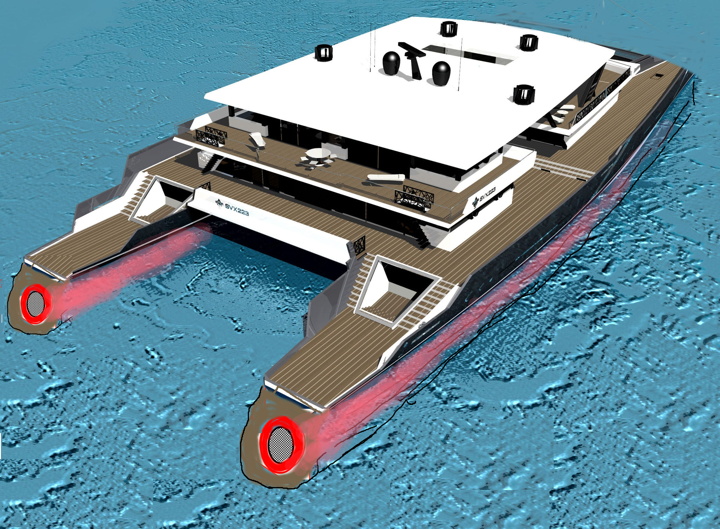
DS902-F9. Notional placing of Marine Arkiducts in catamaran/hydrofoil vessel. Base image from [12].
In this configuration, the Arkiducts would be placed at the bottoms of the twin keels. It might be found to be efficient to use such a configuration even for very large container or tanker ships, essentially ending up as wide platforms with twin Arkiduct propulsion pods beneath them.
With a catamaran configuration, a shelved base to the main structure might be appropriate so that movement forward of the vessel would tend to lift it somewhat in the water.
Final Remarks
When measured in tonnage, the majority of items figuring in international trade travel by ship. The three main modes are container ships, tankers, and bulk carriers.
Probably it is bulk carriers which carry the biggest tonnages. As an example, Australia exports by ship 800 million tonnes of iron ore each year -- over 30 tonnes per inhabitant.
So an improvement in the efficiency of shipping would have an influence on international economics. Fitting large ships with Arkiducts in place of the current screw propellors is likely to lead to significant improvements in efficiency and hence lower costs.
References and Links
[1] David Noel. DS901: The Arkiduct Device: Towards axle-less propulsion and delivery. http://www.aoi.com.au/devices/Arkiduct/index.htm .
[2] Tim Stafford. How Much Does a Cargo Ship Weigh. https://boatinggeeks.com/how-much-does-a-cargo-ship-weigh/ .
[3] Archimedes' Screw and Hanging Gardens of Babylon. https://www.youtube.com/watch?time_continue=60&v=NhNEB_mWvBw .
[4] Noah Wiener. Hanging Gardens of Babylon in Assyrian Nineveh. https://www.biblicalarchaeology.org/daily/news/hanging-gardens-of-babylon-in-assyrian-nineveh/ .
[5] Smita Singla. 8 Biggest Ship Propellers in the World. https://www.marineinsight.com/tech/8-biggest-ship-propellers-in-the-world/ .
[6] Development of the Screw Propeller. https://www.shippingwondersoftheworld.com/screw_propeller.html .
[7] Stone Marine Propulsion. Cavitation of Propellers. http://www.smpropulsion.com/technical/pdfs/Cavitation%20of%20Propellers%20NL.pdf .
[8] Cavitation. https://en.wikipedia.org/wiki/Cavitation .
[9] Vessel Hull Services. https://www.rhinocentre.com/product/vessel-hull-services/ .
[10] Kat Walden. The Fastest Swimming Dolphin Species. https://animals.mom.me/fastest-swimming-dolphin-species-6259.html .
[11] Top 10: What are the fastest fish in the world?. https://www.sciencefocus.com/nature/top-10-what-are-the-fastest-fish-in-the-world/ .
[12] Catamaran mega-yacht SVX 223' - 68M. https://www.nauticexpo.com/prod/sea-voyager/product-24923-501728.html .
[13] David Noel. HY401: Hydrogen is Very Very Safe. http://www.aoi.com.au/Hydrogen/HY401/ .
* * * * * * * * * * * * * * * * * *

Go to the Devices Home Page

Version 1.0 published as "Arkiduct Propulsion in Large Marine Vessels" in CALIBRE - Revista Brasiliense de Engenharia e Física Aplicada, Vol 6 (1), 2021. ◽
V 1.1 for AOI begun 2022 May 27, placed on Web 2022 May 29.








.jpg)



